Are you considering taking the P 15 Test Form? If so, you’ve come to the right place! This blog post will provide all of the information and resources you need in order to make an informed decision about whether or not this test is right for you. We'll cover important details like what's on the exam, how it's scored, necessary accommodations, and often asked questions from potential test takers. Ultimately, understanding all of these aspects can help ensure that you're fully prepared for your upcoming experience with P 15 Test Form. Read on for everything you need to know about this assessment pre-test!
| Question | Answer |
|---|---|
| Form Name | P 15 Test Form |
| Form Length | 27 pages |
| Fillable? | No |
| Fillable fields | 0 |
| Avg. time to fill out | 6 min 45 sec |
| Other names | study material for the certificate of fitness for p 15 2019, p 15 practice test, p 15 certificate of fitness, p15 certificate of fitness |
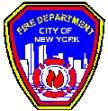
NEW YORK CITY FIRE DEPARTMENT
BUREAU OF FIRE PREVENTION
STUDY MATERIAL FOR THE CERTIFICATE OF FITNESS FOR:
HANDLE MOTOR
AND FLEET SERVICE STATION
(The new test is available on 11/21/2011)
©10/2011 New York City Fire Department - All rights reserved
A
|
CONTENT |
|
NOTICE OF EXAMINATION |
I |
|
STUDY MATERIAL AND TEST DECRIPTION |
II |
|
FIRE STATISTICS AND FACTS |
1 |
|
PART 1. INTRODUCTION |
2 |
|
1.1 |
Permit |
2 |
1.2 |
Certificate of Fitness |
2 |
PART 2. MOTOR |
3 |
|
2.1 |
Motor Fuel Service Station |
3 |
2.1.1 |
Automotive Service Station |
3 |
2.1.2 |
Marine Service Station |
3 |
2.1.3 Service Stations Located Inside Buildings |
3 |
|
2.2 |
Tanks and Tank Trucks |
4 |
2.2.1 Transfer of motor fuel from tank truck to storage tank |
5 |
|
2.3 |
Dispensing Motor Fuel |
5 |
2.3.1 |
Approved portable containers |
7 |
PART 3. SUPERVISION, RECORDS AND REPORT |
8 |
|
3.1 |
8 |
|
3.2 |
Fleet Motor |
10 |
3.3 |
Inventory Control for Underground Tanks |
10 |
Example of the maintenance log book |
12 |
|
3.4 |
Inspections and Tests Records |
13 |
3.5 |
Reporting of Spills and Discharges |
13 |
PART 4. SAFETY REGULATIONS AND FIRE CONTROL |
14 |
|
4.1 |
Labeling and Signage |
14 |
4.1.1 Color coding and symbols of fill ports |
14 |
|
4.1.2 |
Warning signs |
15 |
4.1.3 |
17 |
|
4.2 |
Control of Ignition, Brush and Debris |
17 |
4.3 |
Emergency Procedure |
18 |
4.4 |
Fire Extinguishers |
20 |
4.4.1 Different types of fire extinguishers |
21 |
|
4.4.2 |
Fire extinguisher inspections |
22 |
4.5 |
Fire Extinguishing System |
23 |
B
|
NOTICE OF EXAMINATION |
Title: |
Examination for the Certificate of Fitness for Motor Fuel Dispensing - |
|
Service Station |
Date of Test:Written tests are conducted Monday to Friday (except legal holidays) 9:00 AM to 2:30 PM.
QUALIFICATION REQUIREMENTS
1.Applicants must be at least 18 years of age.
2.Applicants must have a reasonable understanding of the English language.
3.Applicants must present a letter of recommendation from his/her employer. The letter must be on official letterhead and must state the applicant’s full name, character, physical condition, experience, and address of premises where applicant will be employed.
4.Applicants must present two (2) forms of satisfactory identification i.e., driver’s license and passport picture ID.
APPLICATION INFORMATION
Application Fees: $25.00 for originals and $15.00 for renewals. The fee may be paid in cash, money order, or personal check payable to New York City Fire Department. The $25.00 fee must be payable by all applicants prior to taking the Certificate of Fitness test. Application forms are available at the Public Certification Unit, 1st floor, 9 MetroTech Center, Brooklyn, NY 11201.
TEST INFORMATION
Test: The test will be of the written, multiple choice type. A passing score of at least 70% is required in order to secure a Certificate of Fitness. Call (718)
I
STUDY MATERIAL AND TEST DECRIPTION
This study material contains the information you will need to prepare for the examination for the Certificate of Fitness for Dispensing Motor Fuel (Automotive Service Stations). It will not be provided to you during the test. It is critical that you read and understand this booklet to help increase your chance of passing this exam. The study material does not contain all of the information you need to know to supervise automotive service stations. It is your responsibility to become familiar with all applicable rules and regulations of the City of New York, even if they are not covered in this study material. You need to be familiar with the Fire Code Chapter 22, Chapter 34, and Fire Rule Chapter 22, Fire Rule Section
Since this Certificate is premise related, Certificate of Fitness must be registered to a given address. Multiple Certificates may be obtained for different stations.
About the Test
All questions on the Certificate of Fitness examination are of the multiple choice type with four alternative answers to each question. Only one answer is most correct for each question. If you do not answer a question, or if you mark more than one alternative your answer will be scored as incorrect. A score of 70% is required on the examination in order to qualify for the Certificate of License. Read each question carefully before marking your answer. There is no penalty for guessing.
SAMPLE QUESTIONS
1.The pumps used to transfer gas from underground tanks must be approved by the:
(A)New York Fire Department
(B)Board of Standards and Appeals
(C)Department of Buildings
(D)Department of Electricity
The correct answer is "B". You would press "B" on your computer terminal.
2. The gasoline storage tanks at a service station must be:
(A)underground only
(B)above ground only
(C)either above ground or underground
(D)easily moved in case of emergency
The correct answer is "C". ". You would press "C" on your computer terminal.
II
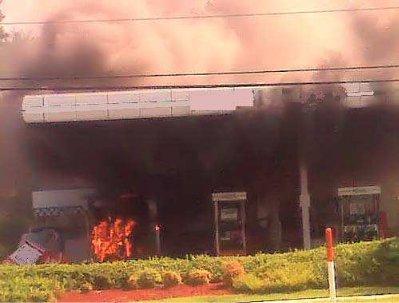
FIRE STATISTICS AND FACTS
According to the Fires at U.S. Service Stations report published by the Fire Analysis and Research Division of the National Fire Protection Association (NFPA) in April, 2011, an estimated 5,020 fires and explosions occurred at public service stations per year from
Fires in these occupancies represent a variety of incidents, including structure fires, vehicle fires, outdoor fires and other fires. The majority of incidents are vehicle fires (61%), but the majority of the property damage (59%), results from structure fires. In structure fires, heating equipment was the leading cause, followed by electrical distribution and lighting equipment. The top three leading items first ignited in structure fires at service stations are flammable or combustible liquids, gases, and associated piping or filter (22%); rubbish, trash, or waste (18%) and electrical cable or insulation (13%).
The leading factors contributing to the ignition of different fires:
Structure Fires:
(1)Electrical failures or malfunctions
(2)Abandoned materials
Vehicle Fires:
(1)Mechanical failures or malfunctions
(2)Electrical failure or malfunction
(3)A flammable liquid or gas being spilled Outdoor and unclassified fires:
(1)Abandoned or discarded materials or products
(2)electrical failures or malfunctions
1
PART 1. INTRODUCTION
1.1Permit
An FDNY
FDNY permits are not transferable, and any change in occupancy, operation, tenancy or ownership requires that a new permit be issued. Appropriate and legal proof of these changes must be submitted to the FDNY. The Certificate of Fitness holder is responsible for making sure that all fire safety regulations and procedures are obeyed on the premises. Permits shall be readily available on the premise for inspection by Fire
Department representatives.
1.2Certificate of Fitness FC2201.7; FC2201.8
At least one
1.The safe storage, handling, use, operation, maintenance, inspection, testing, repair and/or supervision of the operation or facility for which the certificate is required, in accordance with this code, the rules, and any other applicable laws, rules and regulations.
2.Notifying the Fire Department/911 of any explosion, fire, reportable leak or other release of hazardous material, or other emergency related to the duties of his or her certificate.
3.Keeping such certificate upon his or her person or otherwise readily available for inspection by any representative of the department, at all times while conducting or supervising the material, operation or facility for which the certificate is required.
The dispensing of liquid motor fuel at motor fuel dispensing facilities shall be conducted by or under the supervision of a
1.Dispensing operations shall be conducted by or under the personal supervision of a
2.Dispensing operations shall be conducted by or under the personal supervision of a
3.Dispensing operations shall be conducted by or under the personal supervision of a
All Permits and Certificates of Fitness shall be readily available on the premises for inspection by Fire Department representatives. No
2
PART 2. MOTOR
2.1 Motor Fuel Service Station
A service station is a location used to store and dispense motor fuels. There are three different types of service stations. The different types are automotive, marine, and stations located inside buildings. Each of these stations is described below.
2.1.1Automotive Service Station
These stations are designed to safely dispense fuel into motor vehicles. The fuels dispensed include gasoline and diesel fuel. The motor fuels are usually stored in underground storage tanks. Fuel tanks of trucks, cars, and motorcycles are filled at these locations. These service stations may also sell batteries, tires and other vehicle accessories, however, the viewing of the dispensing area from the control booth must be unobstructed and the tank area must be clear and free. Vehicle maintenance and minor repairs may also be performed at these stations.
(A)FLEET AUTOMOTIVE LIQUID MOTOR
(B)FULL SERVICE AUTOMOTIVE LIQUID MOTOR
(C)
2.1.2Marine Service Station
This station is usually located on a pier, a wharf or a floating dock. This station is designed to safely dispense fuel into
2.1.3Service Stations Located Inside Buildings
These stations are located within a building structure that contains other occupancies. The station is designed to safely dispense fuels into motor vehicles. The motor fuels are stored in above ground or underground storage tanks.
3

2.2Tanks and Tank Trucks FC2206.9.6
Only approved tanks may be used to store motor fuel. Approved tanks are those tanks that meet the design and safety specifications of the Fire Commissioner's Office. An accurate log of the contents of the tanks must be recorded. This log must be completed by the Certificate of Fitness holder. This record should include the amount of fuel sold each day and the amount of fuel in the tank. The tanks must be inspected daily. They should be checked for defective equipment and leaks. If any leaks or defects are discovered, the
Individual underground storage tanks shall not exceed a capacity of 12,000 gallons. The capacity of an aboveground tank shall not exceed 4,000 gallons. The aggregate capacity at a facility in both aboveground and underground tanks shall not exceed 40,000 gallons.
Tank trucks are used to transfer motor fuel into the storage tanks. The motor fuel might be transferred by gravity and/or by pump pressure (diesel only) from the tank truck into the storage tank. The Certificate of Fitness holder should observe the filling of the storage tanks on the premises. The Certificate of Fitness holder must ensure the fill boxes are free of products after the delivery is completed. The motor of the tank truck should be shut off while making the transfer, unless the transfer pump is in use.
Chock blocks should be placed under the wheels of the truck. The chock blocks prevent the truck from moving.
The Certificate of Fitness holder make sure that the vapor return line (vapor recovery stage I) is securely connected to the storage tank and the tank truck. The vapor return line prevents the flammable vapors from escaping into the atmosphere. The motor fuel discharge line must also be checked to make sure that it is securely connected to the tank truck and the storage tank. If any leaks are noticed the transfer should be stopped immediately. The defects or the leaks must be repaired before transferring any more
4

motor fuel into the storage tank. The transfer of motor fuel from a tank truck to a storage tank is shown below.
2.2.1Transfer of motor fuel from tank truck to storage tank
A test well or gauge line on the storage tank allows the attendant to determine how much fuel is in the storage tank. The Certificate of Fitness holder and the driver making the delivery are both responsible to be sure that the test well connection is closed while filling the tanks. The test well may not be opened to speed up the filling of the storage tank. It must remain closed to make sure that no flammable vapors escape into the atmosphere. The test well may only be used to determine the amount of motor fuel in the storage tank.
The Certificate of Fitness holder must know the layout of the fuel storage system. The location of the test well, the fill line, the vent line, and the product line to the dispensers must be known. The Certificate of Fitness holder should know how to use the test well and measuring stick to determine the amount of motor fuel in a storage tank. The measuring stick is used in the same way a dipstick is used to determine the level of oil in an automobile engine. First, the measuring stick must be wiped clean. The stick is then inserted into the test well. The measuring stick is then removed and read. The stick is read by comparing the level of fuel on the stick to the measurement marks on the stick. This method allows the Certificate of Fitness holder to estimate the amount of fuel in the tank. The Certificate of Fitness holder must know this information to make sure that the tank is not overfilled accidentally. An operating manual containing emergency procedures, and operating procedures (including the operation of the suppression systems) must be maintained in the control booth. All tanks servicing the fire suppression system must have gauges, which shall be positioned so as to be easily read from grade.
2.3 Dispensing Motor Fuel
Fuel is dispensed into a customer's vehicle using a fuel pump. These pumps are usually powered by electricity. All of the pumps are connected to an electrical circuit breaker. The breaker allows the pumps to be quickly shut off in case of an emergency. The fuel is pumped through a hose when filling the vehicle. The maximum acceptable length of the
5
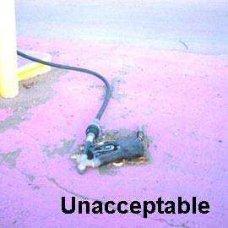
dispensing hose for automotive service stations is 18 feet. Never attempt to use a longer hose. Instead move the vehicle closer to the dispenser. Marinas may have longer hoses if they are approved by the Fire Commissioner.
The pump has a dispensing control device installed. The control device is usually a lever installed next to a nozzle holding bracket. The control device may be turned on only when the dispensing nozzle is taken out of its holding bracket. It may be shut off when the dispensing nozzle is placed back into the holding bracket. No attempt should be made to bypass this control device.
The nozzle must be placed back into holding bracket after use. The hose and nozzle must never be left laying on the ground. If the hose and nozzle are on the ground they are exposed to physical damage. This damage may result in leaks and malfunctions of the system. Keeping the nozzle in the holding bracket reduces the risk of the hose being damaged. The hose and nozzle must always be replaced in the holding bracket when not in use. The length of the dispensing hose shall be such that at least 1 inch clearance between the hose and the ground is maintained when the nozzle is rested on its bracket.
Before pumping motor fuel into a vehicle the nozzle must be grounded. This is done by touching the nozzle against the steel bumper or chassis of the car. Grounding eliminates static electricity. Static electricity has the potential to cause a spark when pumping the motor fuel. A single spark may ignite the gasoline vapors. Grounding makes sure that a fire or explosion does not occur while dispensing the motor fuel. The vehicle's motor must always be turned off before fuel is pumped into the vehicle's tank.
In some service stations a vapor recovery system is installed. This system is designed to capture the vapors that escape when dispensing motor fuel. These vapors are potentially dangerous. They may be ignited by sparks or open flames. A shroud is installed over the nozzle. This shroud draws the vapors into a hose. The hose is connected to the storage tank. If the vapor recovery system is installed the Certificate of Fitness holder must make sure that it is working correctly.
When the service station is located inside a building fuel vapors may accumulate. If the vapors are ignited they may cause an explosion. In order to prevent an explosion the service station must be well ventilated. The Certificate of Fitness holder must make sure that the area is well ventilated. The area may be ventilated using an exhaust system. The system must always be in good working order. The ventilation system is designed to automatically operate before the fuel is pumped into the vehicle. An automatic control device will not allow the pump to function unless the exhaust system is working. No attempt should be made to bypass this control device. Any defects in the system must be repaired as soon as they are noticed. No attempt to pump fuel may be made when the exhaust system is not working.
6
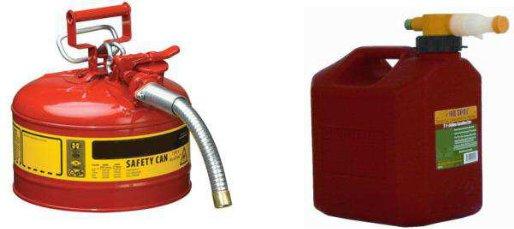
2.3.1Approved portable containers
(FC2204.4)
ONLY the
Permits to transport motor fuel in a portable container larger than 2.5 gallons shall be required. Such permits shall be issued to a particular vehicle or marine vessel for such transportation. The
Liquids shall not be dispensed into portable tanks or cargo tanks. Portable containers shall not be filled while located inside the trunk, passenger compartment or truck bed of a vehicle or upon a watercraft. This is to make sure that no motor fuel is accidentally spilled into the trunk of the vehicle. No motor vehicle, motorcycle or watercraft shall be fueled from a portable container while inside a building or structure.
Examples of an approved gasoline container is shown below:
7
PART 3. SUPERVISION, RECORDS AND REPORT
(FC2204.2; FC2204.6; FC2204.7;FC2204.8;Rule
FC2205.2; DEC613.8)
The dispensing of liquid motor fuel at an automotive liquid motor
Persons dispensing motor fuel at a
It shall be unlawful to smoke, use or maintain an open flame in areas where fuel is dispensed. The engines of vehicles being fueled shall be shut off during fueling. Electrical equipment shall be installed, operated and maintained in accordance with the Electrical Code.
Approved emergency controls shall be provided. Dispenser operating instructions shall be conspicuously posted in approved locations on every dispenser and shall indicate the location of the emergency controls. An approved emergency procedures sign shall be provided and posted.
3.1
In these service stations the customers pump motor fuel into their fuel tanks. Although the Certificate of Fitness holder does not pump the fuel for the customer, he/she must be on the premises while the self service station is open for business. The Certificate of Fitness holder must observe the dispensing of motor fuel into the customers' tanks. Any unsafe dispensing procedures must be stopped immediately. For example, motor fuel should be pumped only into approved containers by the Certificate of Fitness holder. The Certificate of Fitness holder must know how to operate the emergency pump shut off breaker. This breaker is designed to shut down the power supply to the fuel pumps. This is the first thing the Certificate of Fitness holder should do in the case of a fire.
The
(a)prevent the dispensing of fuel into containers that do not comply with the requirements of FDNY,
(b)control sources of ignition,
(c)take immediate action upon an accidental spill or release,
(d)be ready to use a portable fire extinguisher,
(e)activate the fixed fire extinguishing system.
Approved
8
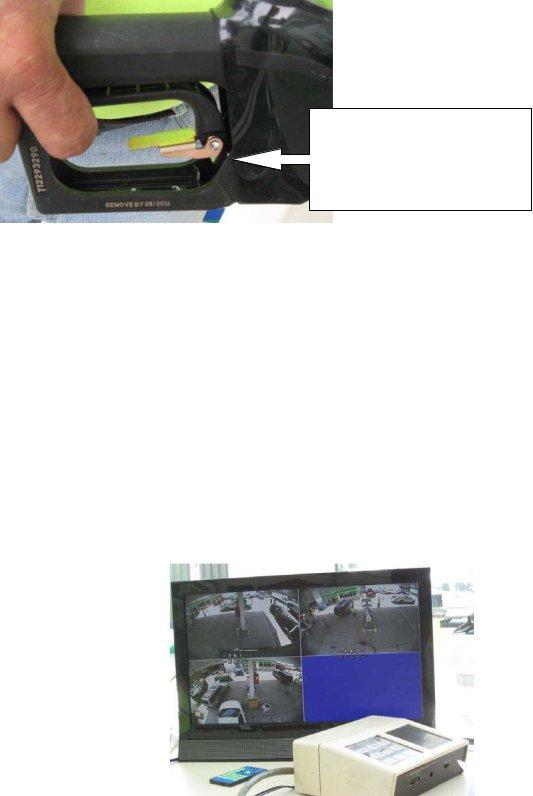
facilities. The
The nozzle must be provided WITHOUT a
(1) Control area (control booth)
A control area shall be located on the premises of every
The
An example of the
9

3.2Fleet Motor
The owner of fleet automotive liquid motor
An approved emergency procedures sign, shall be posted in a conspicuous location and shall read:
IN CASE OF FIRE, SPILL OR RELEASE
1.USE EMERGENCY PUMP SHUTOFF
2.ACTIVATE THE FIRE EXTINGUISHING SYSTEM PROTECTING THE FLAMMABLE LIQUID MOTOR FUEL DISPENSING AREA. (where applicable) FIRE SUPPRESSION EMERGENCY CONTROL LOCATED (indicate location)
3.NOTIFY THE FIRE DEPARTMENT (CALL 911)
FACILITY ADDRESS (indicate address, with cross street reference).
A telephone not requiring a coin to operate or other approved, clearly identified means to notify the department shall be provided at the facility in an approved location.
Dispensing equipment used at fleet automotive liquid motor
1.Dispensing devices shall be programmed or set to limit uninterrupted liquid motor fuel delivery to not more than 25 gallons and require a manual action to resume delivery.
2.For other than flammable liquid motor fuel, the amount of liquid motor fuel being dispensed shall be limited in quantity by a preprogrammed card as approved.
3.3Inventory Control for Underground Tanks
(1) Daily inventory records
Accurate daily inventory records shall be maintained and reconciled for underground liquid motor fuel storage tanks for indication of possible leakage from tanks and piping. Inventory reconciliation shall be in accordance with the regulations of the New York State Department of Environmental Conservation as set forth in 6 NYCRR Part 613. The records shall be kept at the premises and be made available for inspection by any representative of the department. Records shall include daily reconciliation between sales, use, receipts and inventory on hand. Where there is more than one system consisting of tanks serving separate pumps or dispensers for a product, the reconciliation shall be maintained separately for each tank system. A consistent or accidental loss of product shall be immediately reported to the commissioner.
10
(2) Maintenance log book.
A maintenance log shall be kept on the premises for inspection by any Department representative. Such log shall list all
(3) Daily inspections.
The
(A)The fire extinguishing system is properly pressurized, nozzles are clear and unobstructed, and heat detectors are undamaged and unobstructed.
(B)Portable fire extinguishers have been serviced and have adequate pressure.
(C)The fire extinguishing system remote manual pull station and the pump shutdown are clear of obstructions.
(D)Leak detection systems and other alarms are in good working order.
(E)Emergency procedures signage is posted, unobstructed and legible.
(F)Required lighting is in good working order.
(G)Any mirrors and/or approved
(H)The voice communications system is in good working order.
11
|
|
|
Example of the maintenance log book |
|
|
|
|
|||
NYC Daily Inspection Log ____________________________ Address _______________________________ |
Month _____________ |
|||||||||
|
|
|
|
|
|
|
|
|
|
|
|
FSS |
EMERGENCY |
SENSORS |
EMERGENCY |
|
|
|
|
|
|
|
ILLUMINATION |
PORTABLE |
|
|
MIRRORS |
|
||||
DATE |
CYLINDERS |
& |
RESPONSE |
INTERCOM |
COMMENTS |
|||||
|
PRESSURE |
SWITCHES & |
NOZZLES |
SIGNAGES |
LIGHTS |
EXTINGUISHERS |
|
|
/CCTV |
|
|
BEACON LIGHT |
|
|
|
|
|
|
|||
1 |
|
|
|
|
|
|
|
|
|
|
2 |
|
|
|
|
|
|
|
|
|
|
3 |
|
|
|
|
|
|
|
|
|
|
4 |
|
|
|
|
|
|
|
|
|
|
5 |
|
|
|
|
|
|
|
|
|
|
6 |
|
|
|
|
|
|
|
|
|
|
7 |
|
|
|
|
|
|
|
|
|
|
8 |
|
|
|
|
|
|
|
|
|
|
9 |
|
|
|
|
|
|
|
|
|
|
10 |
|
|
|
|
|
|
|
|
|
|
11 |
|
|
|
|
|
|
|
|
|
|
12 |
|
|
|
|
|
|
|
|
|
|
13 |
|
|
|
|
|
|
|
|
|
|
14 |
|
|
|
|
|
|
|
|
|
|
15 |
|
|
|
|
|
|
|
|
|
|
16 |
|
|
|
|
|
|
|
|
|
|
17 |
|
|
|
|
|
|
|
|
|
|
18 |
|
|
|
|
|
|
|
|
|
|
19 |
|
|
|
|
|
|
|
|
|
|
20 |
|
|
|
|
|
|
|
|
|
|
21 |
|
|
|
|
|
|
|
|
|
|
22 |
|
|
|
|
|
|
|
|
|
|
23 |
|
|
|
|
|
|
|
|
|
|
24 |
|
|
|
|
|
|
|
|
|
|
25 |
|
|
|
|
|
|
|
|
|
|
26 |
|
|
|
|
|
|
|
|
|
|
27 |
|
|
|
|
|
|
|
|
|
|
28 |
|
|
|
|
|
|
|
|
|
|
29 |
|
|
|
|
|
|
|
|
|
|
30 |
|
|
|
|
|
|
|
|
|
|
31 |
|
|
|
|
|
|
|
|
|
|
12
3.4 Inspections and Tests Records
(FC 2205.2.3)
Records of all inspections and testing shall be recordkeeping, maintained on the premises for a inspection by a representative of the department.
kept in a bound log book or other approved minimum of 5 years, and made available for
3.5 Reporting of Spills and Discharges
The results of any inventory record, test or inspection which shows a facility is leaking must be reported to Bulk Fuel Safety Unit of FDNY and Department of Environmental Conservation (DEC) within 2 hours of the discovery.
All petroleum spills that occur within New York State (NYS) must be reported to the NYS Spill Hotline
1.The quantity is known to be less than 5 gallons; and
2.The spill is contained and under the control of the spiller; and
3.The spill has not and will not reach the State's water or any land; and
4.The spill is cleaned up within 2 hours of discovery.
A spill is considered to have not impacted land if it occurs on a paved surface such as asphalt or concrete. A spill in a dirt or gravel parking lot is considered to have impacted land and is reportable.
More details on notification and reporting requirements can be found in the document posted by the Department of Environmental Conservation (http://www.dec.ny.gov/docs/remediation_hudson_pdf/1x1.pdf).
(The spill responses can be referred to http://www.dec.ny.gov/chemical/8692.html)
13
PART 4. SAFETY REGULATIONS AND FIRE CONTROL
NFPA 30A 9.2.5.1; FC2205.5; FC2205.7;FC2206.8; FC2206.9.4; Rule
4.1 Labeling and Signage
4.1.1Color coding and symbols of fill ports (DEC613.3(b)(2), DEC613.3(b)(3))
The owner or operator must permanently mark all fill ports to identify the product inside the tank. These markings must be consistent with the color and symbol code of the American Petroleum Institute which follows. The colors to be used are:
(i) |
High gasoline |
Red |
|
|
|
(ii) |
Middle gasoline |
Blue |
|
|
|
(iii) |
Lower gasoline |
White |
|
|
|
(iv) |
High unleaded gasoline |
Red w/white cross |
|
|
|
(v) |
Middle unleaded gasoline |
Blue w/white cross |
|
|
|
(vi) |
Lower unleaded gasoline |
White w/black cross |
|
|
|
(vii) |
Vapor recovery |
Orange |
|
|
|
(viii) |
Diesel |
Yellow |
|
|
|
(ix) |
#1 fuel oil |
Purple w/yellow bar |
|
|
|
(x) |
#2 fuel oil |
Green |
|
|
|
(xi) |
Kerosene |
Brown |
|
|
|
The symbols to be used are:
(ii)a circle for gasoline products and vapor recovery lines;
(iii)hexagon for other distillates; and
(iv)a border must be painted around fuel products containing extenders such as alcohol. The border will be black around a white symbol and white around all other colors.
14
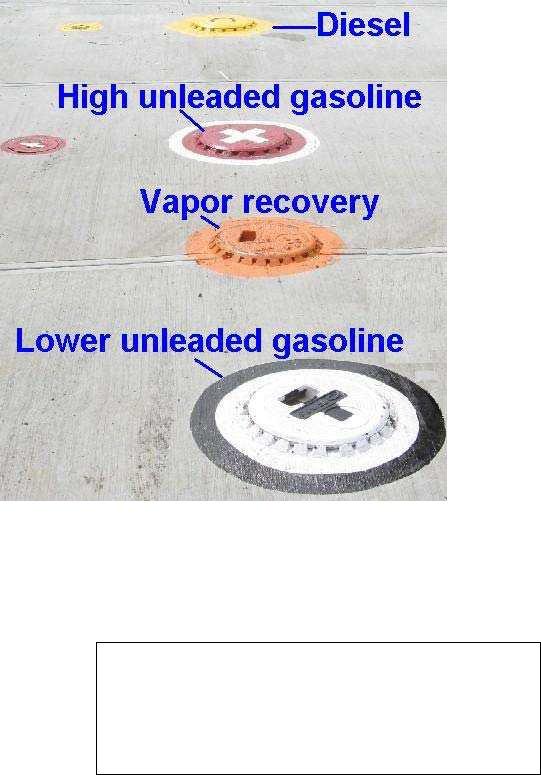
4.1.2Warning signs (FC2204.2.6, FC2204.2.3)
(1) Control area sign.
A durable metal sign that reads as follows shall be posted in plain view within the control area:
Emergency Procedures: Shut off product pumps.
Direct vehicle occupants to exit vehicles and leave area
immediately.
Keep all persons away from the area.
Manually activate fire extinguishing system.
Notify the Fire Department (Call 911).
15
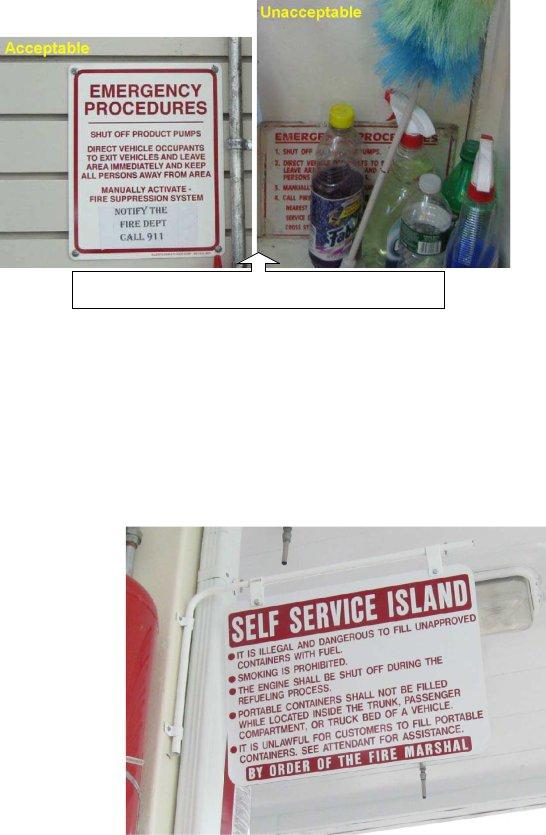
The view of the sign should not be obstructed.
(2) Dispensing area signs and instructions.
Durable warning signs shall be conspicuously posted on or immediately adjacent to each dispenser in the
1.It is illegal and dangerous to fill unapproved containers with fuel.
2.Smoking is prohibited.
3.The engine shall be shut off during the refueling process.
4.Portable containers shall not be filled while located inside the trunk, passenger compartment, or truck bed of a vehicle.
5.It is unlawful for customers to fill portable containers. See attendant for assistance.
Dispenser operating instructions shall be conspicuously posted in approved locations on every dispenser and shall indicate the location of the emergency controls.
16
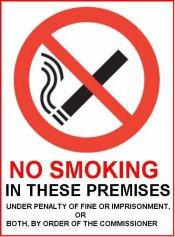
4.1.3
Motor fuels are flammable and easily ignited. For this reason no smoking is permitted anywhere on the premises. This applies to customers as well as employees.
The material should be made of heavy cardboard stock or other approved durable material for indoor locations. For outdoor locations, or indoor locations where the signs may be exposed to conditions that will accelerate deterioration, metal or other approved durable material that is water- resistant. The signs must be posted indicating that no smoking is permitted on the premises and must include procedures to be followed in case of a fire emergency. An example of a No Smoking sign is shown below:
There will be no servicing or repair of motor vehicles in areas used for dispensing. Safety regulations must be posted in visible locations in the gas station. A sign displaying the name and address of the owner of service station must be displayed in a visible location. This sign must also give the name of the person responsible for testing the fuel dispensing system. Phone numbers where these people can be reached 24 hours a day, 7 days a week must be included on the sign. The Certificate of Fitness holder must make sure that this sign is visible at all times.
4.2 Control of Ignition, Brush and Debris
Motor fuel should never be used to wash or clean automobile engines. This is extremely dangerous as the motor fuels are easily ignited by the heat generated by the engine.
Oily rags are also a potential fire hazard. The oily rags may be easily ignited by a spark or an open flame. Oily rags used in the service station should be stored in a listed disposal container. This container should have a
17
Smoking materials, including matches and lighters, must not be used within 20 ft of areas used for fueling, servicing fuel system of internal combustion engines, or receiving or dispensing of motor fuel liquids. The
Brush, grass, vines or other vegetation and combustible waste shall be kept not less than 10 feet from the tank and dispensing location.
4.3Emergency Procedure (FC 2203.2)
The Certificate of Fitness holder must know where all control devices and fire extinguishers are located in the station. The Certificate of Fitness holder should know how to operate the control devices and extinguishers in emergency situations.
An approved, clearly identified and readily accessible emergency disconnect switch shall be provided at an approved location, to immediately shut down the transfer of fuel to the fuel dispensers in the event of a fuel spill or other emergency. An emergency disconnect switch for exterior fuel dispensers shall be located within 100 feet of, but not less than 20 feet from, the fuel dispensers. For interior
If a fire occurs within the service station, the Certificate of Fitness holder must activate the fire suppression system FIRST and then push the emergency fuel
The Certificate of Fitness holder should know how to operate the fire extinguishing systems for the fuel pumps. The system is designed to activate automatically in case of emergency. The system can also be operated manually. The primary method is to pull the lever on the Manual Control Box. If the manual pull lever does not function, the attendant should pull the pin on the nitrogen cylinders that are located in or near the booth.
18
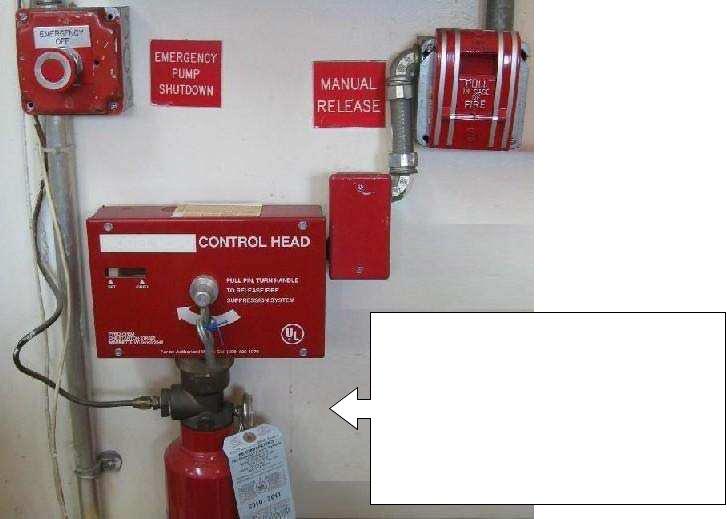
1. 2.
3.
1. The emergency fuel
The pump must be quickly shut off in case of an emergency.
Discharge the fire extinguishing system manually by:
2. the Manual Control Box or
3. the pin on the nitrogen cylinders.
A telephone call to the Fire Department shall be followed upon noticing an emergency. The Fire Department should always be notified in case of a fire and a large spill of fuel (e.g. equal to or more than 5 gallons).
The Certificate of Fitness holder should pour sand or other absorbing material on a motor fuel spill to stop the flow and soak up the fuel on pavement. "Speedy Dry" (like cat litter) is commonly used to contain and soak up motor fuel spills. Not all absorbents can make petroleum nonflammable.
The area should then be cleaned up using approved materials. Brooms can be used to sweep up the absorbent material and put it into buckets, garbage cans or barrels. Remember to control ignition sources. If a large spill or leak occurs (e.g. more than 5 gallons), the local Fire Department must be notified immediately. If the fire suppression system or portion of the fire suppression system has been discharge or is inoperative, it must be the responsibility of the attendant to ensure that the Fire Department is notified.
19
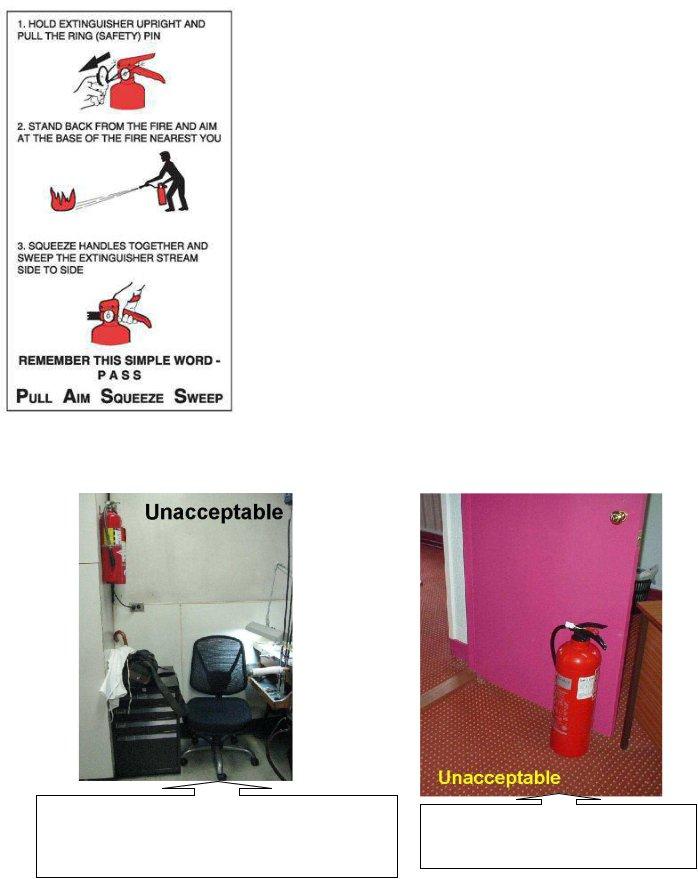
4.4 Fire Extinguishers
Approved portable fire extinguishers with a minimum rating of
Fire extinguishers must be used in accordance with the instructions painted on the side of the extinguisher. They clearly describe how to use the extinguisher in case of an emergency. The Certificate of Fitness holder should become familiar with the instructions for the extinguisher at his/her work site. When it comes to using a
All fire extinguishers must be installed so that the top of the extinguisher is not more than 5 ft above the floor and the clearance between the bottom of the extinguisher and the floor is not less than 4 in. In other words, no fire extinguisher is allowed to be on the floor.
(1)The top of the fire extinguishers must not be more than 5 ft above the floor.
(2)The fire extinguishers must be accessible and unobstructed.
20
The bottom of the extinguisher must be at least 4 in above the floor.
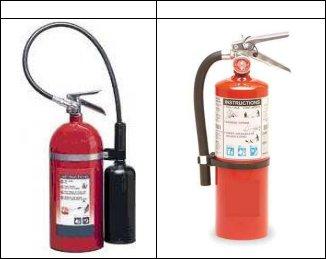
4.4.1Different types of fire extinguishers
The Certificate of Fitness holder must be familiar with the different types of fire extinguishers available at the work site. The Certificate of Fitness holder must know how to operate the extinguishers in a safe and efficient manner. The Certificate of Fitness holder must also know the difference between the various types of extinguishers and when they may be used. A description of the classes of fires and the appropriate extinguishers are described below.
CLASS A fires are caused by ordinary combustible materials (such as wood, paper, and cloth). To extinguish a Class A fire, these extinguishers utilize either the
CLASS B fires are caused by flammable or combustible liquids and gases such as oil, gasoline, etc. To extinguish a Class B fire, the
CLASS C fires involve electrical equipment. These fires must be fought with fire extinguishers that do not conduct electricity. Foam and water type extinguishers must not be used to extinguish electrical fires. After shutting off the electrical equipment, extinguishers for Class A or B fires may be used.
CLASS D fires are caused by ignitable metals, such as magnesium, titanium, and metallic sodium, or metals that are combustible under certain conditions, such as calcium, zinc, and aluminum. Generally, water should not be used to extinguish these fires.
A
Examples of fire extinguishers
Symbols may also be painted on the extinguisher. The symbols indicate what kind of fires the extinguisher may be used on. Examples of these symbols are shown below.
21
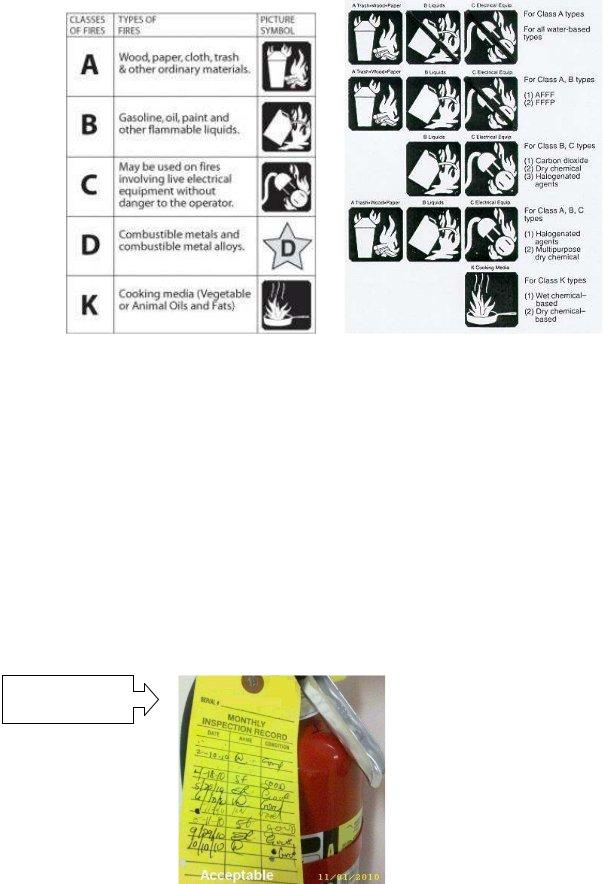
Fire Extinguisher Identification Symbols
The symbol with the shaded background and the slash indicates when the extinguisher must not be used. The Certificate of Fitness holder must understand these symbols. All fire extinguishers should be kept in good working order at all times.
4.4.2Fire extinguisher inspections
The extinguishers are required to be inspected monthly. The owner of the premises is responsible to designate a person to perform a monthly inspection. This inspection is a "quick check" that a fire extinguisher is available and will operate. It is intended to give reasonable assurance that the fire extinguisher is fully charged and operable. This is done by verifying that it is in its designated place, that it has not been actuated or tampered with, and that there is no obvious or physical damage or condition to prevent its operation. The information of the monthly inspection record must include the date the inspection was performed, the person performing the inspection, and those portable fire extinguishers found to require corrective action. Such recordkeeping must be either attached to the extinguisher or on an inspection checklist maintained on file. Labels or markings indicating fire extinguisher use, or classification, or both shall be placed on the front of the fire extinguisher. At least once per year, all fire extinguishers must be maintained by a FDNY approved company and a
Monthly inspection tag.
22
4.5 Fire Extinguishing System
Where flammable liquid motor fuel is dispensed at an automotive liquid motor
1.The fire extinguishing system shall be designed to provide overhead protection of the dispenser area encompassed by a circle formed by the fully extended hose and nozzle on each fuel dispenser and both ends of the dispenser island.
2.The extinguishing agent containers shall be equipped with indicators to show whether the system is fully charged. Indicators shall be positioned to be easily read from grade.
3.The installation, alteration, testing and repair of the fire extinguishing system, including any maintenance or modification of the system, shall be performed by a person possessing a master fire suppression piping contractor license issued by the New York City Department of Buildings and certified in the installation, operation and maintenance of the specific fire extinguishing system.
4.Dispensers shall not be operated when the fire extinguishing system has discharged or is inoperative, except as authorized in writing by the department. The motor
5.A performance test of the fire extinguishing system shall be performed at the time of installation in accordance with the approved design and installation documents, and such procedures as may be prescribed by the commissioner. Fire extinguishing systems shall be tested at least once every 5 years from the date of the first test of the initial installation. The test shall be in accordance with procedures prescribed by the commissioner.
6.Fire extinguishing systems at fleet vehicle automotive liquid motor
23